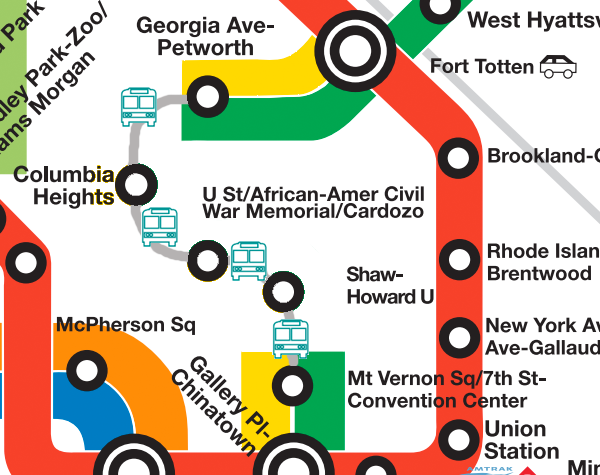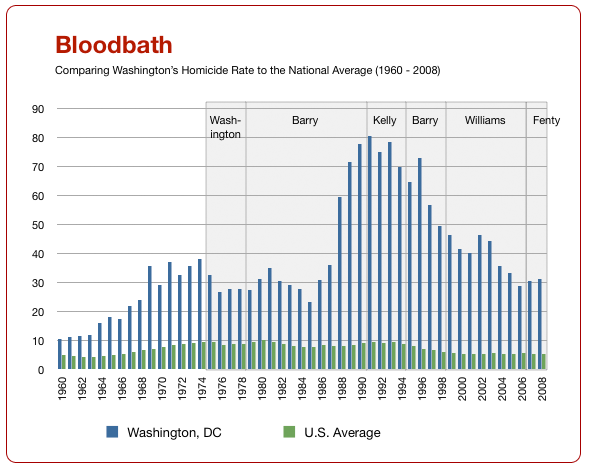Weekend Metro closure may bring unintended improvement

Temporarily closing a segment of the Green Line might ironically improve service for some this weekend. WMATA announced that it will close the Shaw, U Street, and Columbia Heights stations this weekend for scheduled track maintenance.
The stations will close at 10 pm Friday and won’t reopen until Tuesday morning’s normal opening time (Monday is a holiday). A similar closure will be in place on the Orange Line between East and West Falls Church stations as Metro works to connect the new Silver Line.
In the meantime, Metro will operate free shuttles along the route to ferry passengers through this service gap. Ironically, these shuttles may sometimes operate more frequently than the rail service would on a typical weekend.
Metro instituted a similar closure along a section of the Red Line on Labor Day weekend. On that weekend, we went to have brunch at a friend’s house in the Brookland neighborhood. During that time, Metro shuttles were running down his street every 2 minutes. Many of the buses were nearly empty, but for a moment we were jealous at the thought of transit service every 2 minutes.
Likewise, if WMATA keeps similarly short headways for the shuttles this weekend, the agency might actually enhance mobility between the Convention Center, Shaw, U Street, Columbia Heights, and Petworth.
One of Metro’s main shortcomings is that riding during non-rush periods, especially on weekends or at night, can entail waiting on platforms for as much as 24 minutes. This is an unacceptably low level of service, but our region lacks the political leadership to set a minimum level of transit service the way we do for utilities.
In DC, where 37% of households lack a car, the mayor and council chairman drive luxury cars at taxpayer expense, and other councilmembers receive free parking in front of the Wilson Building.
In the abstract, our leaders may appreciate the importance of frequent service, but nothing drives home the point like waiting on a Metro platform with 100 other people only to watch a packed train arrive half an hour later.
Though buses can’t match the speed and comfort of rail service, the frequency of bus shuttles this weekend might prove to be a significant, though temporary, transit improvement.
Building from the Ground Up
Watch this neat time-lapse video covering the entire construction of the Kenyon Square building at Fourteenth and Kenyon Streets in Columbia Heights.
DC Homicide Rates Decline, Still Too High

We were walking through Columbia Heights late Saturday night and noticed numerous police cars rushing south toward Columbia Road. Later that evening we learned the terrible news that a nine-year-old boy was murdered in his apartment by one bullet shot through his front door. Though the assailant may not have been aiming for the boy specifically, shooting anywhere in an apartment building is bound to hurt somebody and we have serious trouble understanding why someone would exhibit such reckless disregard for human life.
This murder occurred despite this increased police presence this weekend as part of the MPD’s All Hands on Deck program. The police, though, cannot be in every hallway in every apartment building.
Closer to home, we became aware of a violent attack that occurred at Second and S Streets in Bloomingdale last week. In an email to the police and several community leaders, Former ANC Commissioner Margot Hoerrner (ANC1B11) described what happened to her friend Brad, who was house-sitting for her:
On Wednesday, at 5pm, Brad was attacked by 6-7 young men, at the corner of 2nd and S Street, who wanted absolutely nothing other than to beat the utter crap out of him. Brad, aside from being a military guy, is also an urban-savvy guy, who said that his instincts never warned him that something was about to happen. On his way to the Big Bear Cafe, half the group rushed him from the front, whereas the other half rushed him from the back. They knocked him down, and then, as a group, stomped on him, jumped on him, and beat him senseless, leaving him with black eyes, thoroughly bloodied and with several cracked ribs.
What’s shocking is that there are too many Washingtonians who think nothing of brutally beating and stomping innocent people.
Ms. Hoerrner added something I’ve often felt: that Washington is more dangerous than many conflict zones and poverty-stricken countries around the world:
As an aside, my work takes me to the poorest, conflict-riddled places in the world. I have spent the last two weeks in Kenya and Tanzania, which are at the precipice of humanitarian and civil disaster because of a four-year drought. A friend of mine has commented on my lack of fear in traveling to these places by myself, and asked me if I’ve ever felt fear traveling anywhere – and I said yes… I have felt more threatened and fearful living in Washington DC than I have anywhere else in the world. I am often stunned at the level of violence and crime that we have come to accept as a given for simply living in this city.
We bring up these problems because we feel that we as a city have become too used to this violence, which is actually abnormal. Washington’s homicide rate for last year was around 32 murders per 100,000 residents, still far off from the 1991 peak of 80.6, but far above the national average (5.8) and more than five times the rate of New York City (6.2).
Making Washington a world-class city requires addressing some of the sicker aspects of our civic culture, particularly our extraordinary rates of violence and our tolerance of violence. We should stand as examples of what a city can be: the elegant, prosperous, and peaceful pinnacle of human civilization and not a place bleeding from occasional bouts of unrelenting brutality.







Recent Comments